AUDI TT COUPE 2014 Workshop Manual
Manufacturer: AUDI, Model Year: 2014, Model line: TT COUPE, Model: AUDI TT COUPE 2014Pages: 284, PDF Size: 34.42 MB
Page 51 of 284
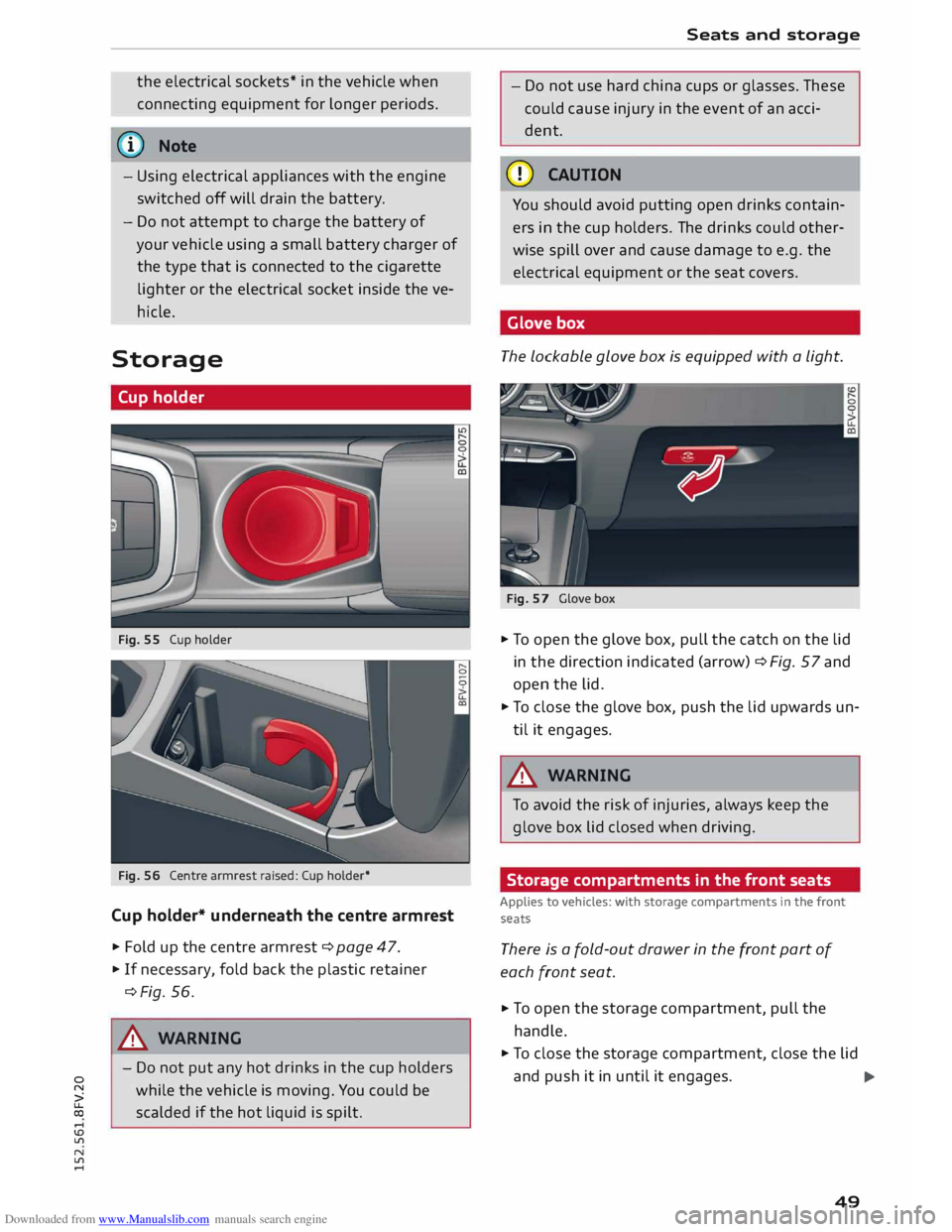
Downloaded from www.Manualslib.com manuals search engine the
electrical sockets* in the vehicle when
connecting equipment for longer periods.
@ Note
- Using electrical appliances with the engine
switched off will drain the battery.
- Do not attempt to charge the battery of
your vehicle using a small battery charger of
the type that is connected to the cigarette
lighter or the electrical socket inside the ve
hicle.
Storage Cup holder
Fig. 55 Cup holder
Fig. 56 Centre armrest raised: Cup holder*
Cup holder* underneath the centre armrest
.. Fold
up the centre armrest ¢ page 47 .
.. If necessary, fold back the plastic retainer
¢Fig. 56.
_&. WARNING
- Do not put any hot drinks in the cup holders
0
� while
the vehicle is moving. You could be
� scalded if the hot liquid is spilt .
.-1
\D U'l
N
U'l
.-1 Seats
and storage
- Do not use hard china cups or glasses. These
could cause injury in the event of an acci
dent.
CD CAUTION
You should avoid putting open drinks contain
ers in the cup holders. The drinks could other
wise spill over and cause damage to e.g. the
electrical equipment or the seat covers.
Glove box
The lockable glove box is equipped with a light.
Fig. 57 Glove box
.. To open the glove box, pull the catch on the lid
in the direction indicated (arrow)¢ Fig. 57 and
open the lid .
.. To close the glove box, push the lid upwards un
til it engages.
_&. WARNING
To avoid the risk of injuries, always keep the
glove box lid closed when driving.
Storage compartments in the front seats
Applies to vehicles: with storage compartments in the front
seats
There is a fold-out drawer in the front part of
each front seat.
.. To
open the storage compartment, pull the
handle.
.. To close the storage compartment, close the lid
and push it in until it engages.
..,.
49
Page 52 of 284
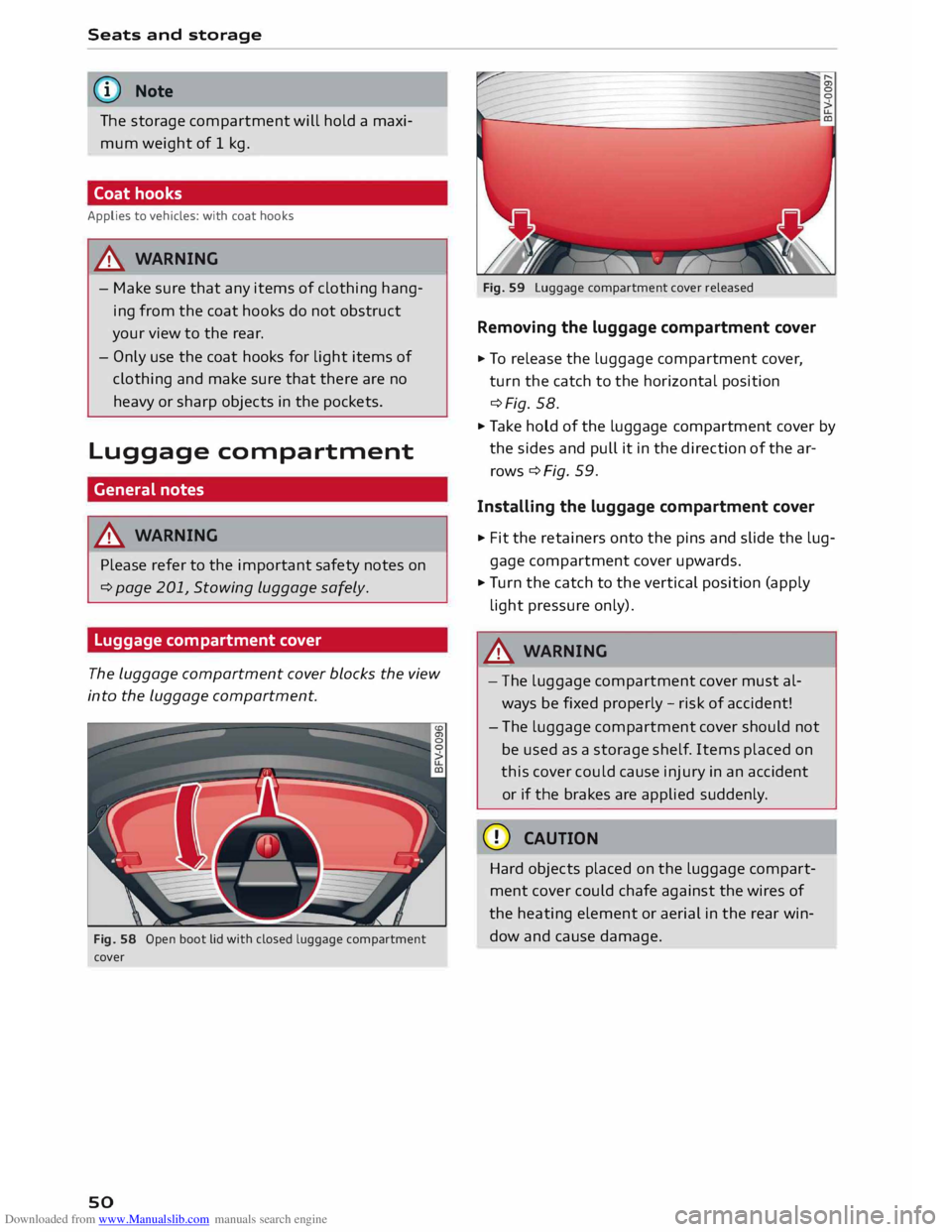
Downloaded from www.Manualslib.com manuals search engine Seats
and storage
@ Note
The storage compartment will hold a maxi
mum weight of 1 kg.
Coat hooks
Applies to vehicles: with coat hooks
.&_ WARNING
- Make sure that any items of clothing hang
ing from the coat hooks do not obstruct
your view to the rear.
- Only use the coat hooks for light items of
clothing and make sure that there are no
heavy or sharp objects in the pockets.
Luggage compartment
General notes
.&_ WARNING
Please refer to the important safety notes on
¢ page 201, Stowing luggage safely.
Luggage compartment cover
The luggage compartment cover blocks the view
into the luggage compartment.
Fig. 58 Open boot Lid with closed luggage compartment
cover
so Fig.
59 Luggage compartment cover released
Removing the luggage compartment cover
� To release the luggage compartment cover,
turn the catch to the horizontal position
¢Fig. 58.
� Take hold of the luggage compartment cover by
the sides and pull it in the direction of the ar
rows ¢Fig. 59.
Installing the luggage compartment cover
� Fit the retainers onto the pins and slide the lug
gage comp artment cover upwards.
� Turn the catch to the vertical position (apply
light pressure only).
.&_ WARNING
- The luggage compartment cover must al
ways be fixed properly -risk of accident!
- Th e luggage compartment cover should not
be used as a storage shelf. Items placed on
this cover could cause injury in an accident
or if the brakes are applied suddenly.
CD CAUTION
Hard objects placed on the luggage compart
ment cover could chafe against the wires of
the heating element or aerial in the rear win
dow and cause damage.
Page 53 of 284
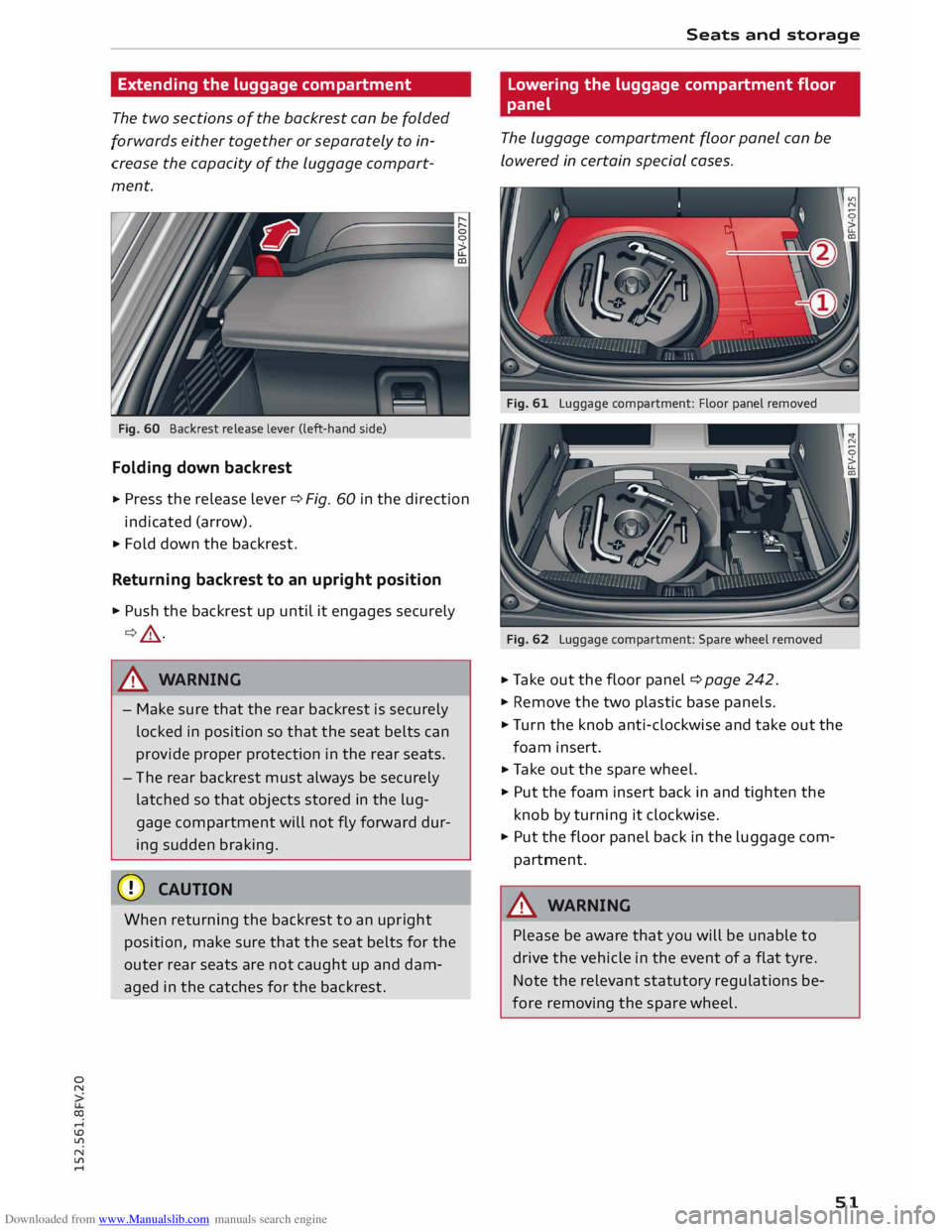
Downloaded from www.Manualslib.com manuals search engine 0
N
co
....
\D L/'l
N
L/'l
.... Extending
the luggage compartment
The two sections of the backrest can be folded
forwards either together or separately to in
crease the capacity of the luggage compart
ment.
Fig. 60 Backrest release lever (left-hand side)
Folding down backrest
"' Press
the release lever
¢ Fig.
60 in the direction
indicated (arrow).
> Fold down the backrest.
Returning backrest to an upright position
> Push the backrest up until it engages securely
¢ &_ .
,8. WARNING
- Make sure that the rear backrest is securely
locked in position so that the seat belts can
provide proper protection in the rear seats.
- Th e rear backrest must always be securely
latched so that objects stored in the lug
gage compartment will not fly forward dur
ing sudden braking.
CD CAUTION
When returning the backrest to an upright
position, make sure that the seat belts for the
outer rear seats are not caught up and dam
aged in the catches for the backrest. Seats
and storage
Lowering the luggage compartment floor
panel
The luggage compartment floor panel can be
lowered in certain special cases.
Fig. 61 Luggage compartment: Floor panel removed
Fig. 62 Luggage compartment: Spare wheel removed
.. Take out the floor panel ¢ page 242.
"' Remove the two plastic base panels.
"' Turn the knob anti-clockwise and take out the
foam insert.
.. Take out the spare wheel.
"' Put the foam insert back in and tighten the
knob by turning it clockwise.
"' Put the floor panel back in the luggage com
partment.
,8. WARNING
Please be aware that you will be unable to
drive the vehicle in the event of a flat tyre.
Note the relevant statutory regulations be
fore removing the spare wheel. -
51
Page 54 of 284
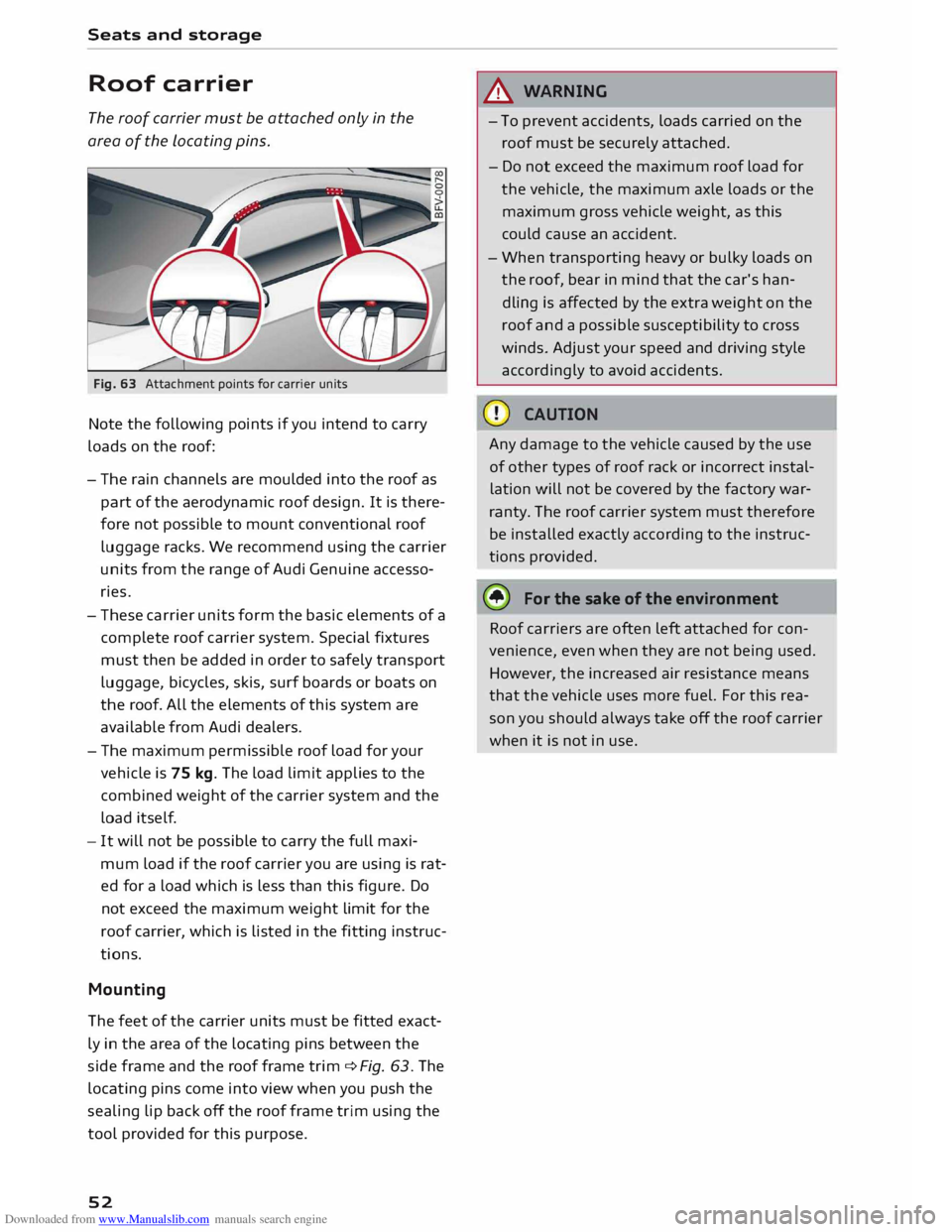
Downloaded from www.Manualslib.com manuals search engine Seats
and storage
Roof carrier
The roof carrier must be attached only in the
area of the Locating pins.
Fig. 63 Attachment points for carrier units
Note the following points if you intend to carry
loads on the roof:
- The rain channels are moulded into the roof as
part of the aerodynamic roof design. It is there
fore not possible to mount conventional roof
luggage racks. We recommend using the carrier
units from the range of Audi Genuine accesso
ries.
- These carrier units form the basic elements of a
complete roof carrier system. Special fixtures
must then be added in order to safely transport
luggage, bicycles, skis, surf boards or boats on
the roof. All the elements of this system are
available from Audi dealers.
- The maximum permissible roof load for your
vehicle is 75 kg. The load limit applies to the
combined weight of the carrier system and the
load itself.
- It will not be possible to carry the full maxi
mum load if the roof carrier you are using is rat
ed for a load which is less than this figure. Do
not exceed the maximum weight limit for the
roof carrier, which is listed in the fitting instruc
tions.
Mounting
The feet of the carrier units must be fitted exact
ly in the area of the locating pins between the
side frame and the roof frame trim qfig. 63. The
locating pins come into view when you push the
sealing lip back off the roof frame trim using the
tool provided for this purpose.
52 &
WARNING
- To prevent accidents, loads carried on the
roof must be securely attached.
- Do not exceed the maximum roof load for
the vehicle, the maximum axle loads or the
maximum gross vehicle weight, as this
could cause an accident.
- When transporting heavy or bulky loads on
the roof, bear in mind that the car's han
dling is affected by the extra weight on the
roof and a possible susceptibility to cross
winds. Adjust your speed and driving style
accordingly to avoid accidents.
Any damage to the vehicle caused by the use
of other types of roof rack or incorrect instal
lation will not be covered by the factory war
ranty. The roof carrier system must therefore
be installed exactly according to the instruc
tions provided.
it!) For the sake of the environment
Roof carriers are often left attached for con
venience, even when they are not being used.
However, the increased air resistance means
that the vehicle uses more fuel. For this rea
son you should always take off the roof carrier
when it is not in use.
Page 55 of 284
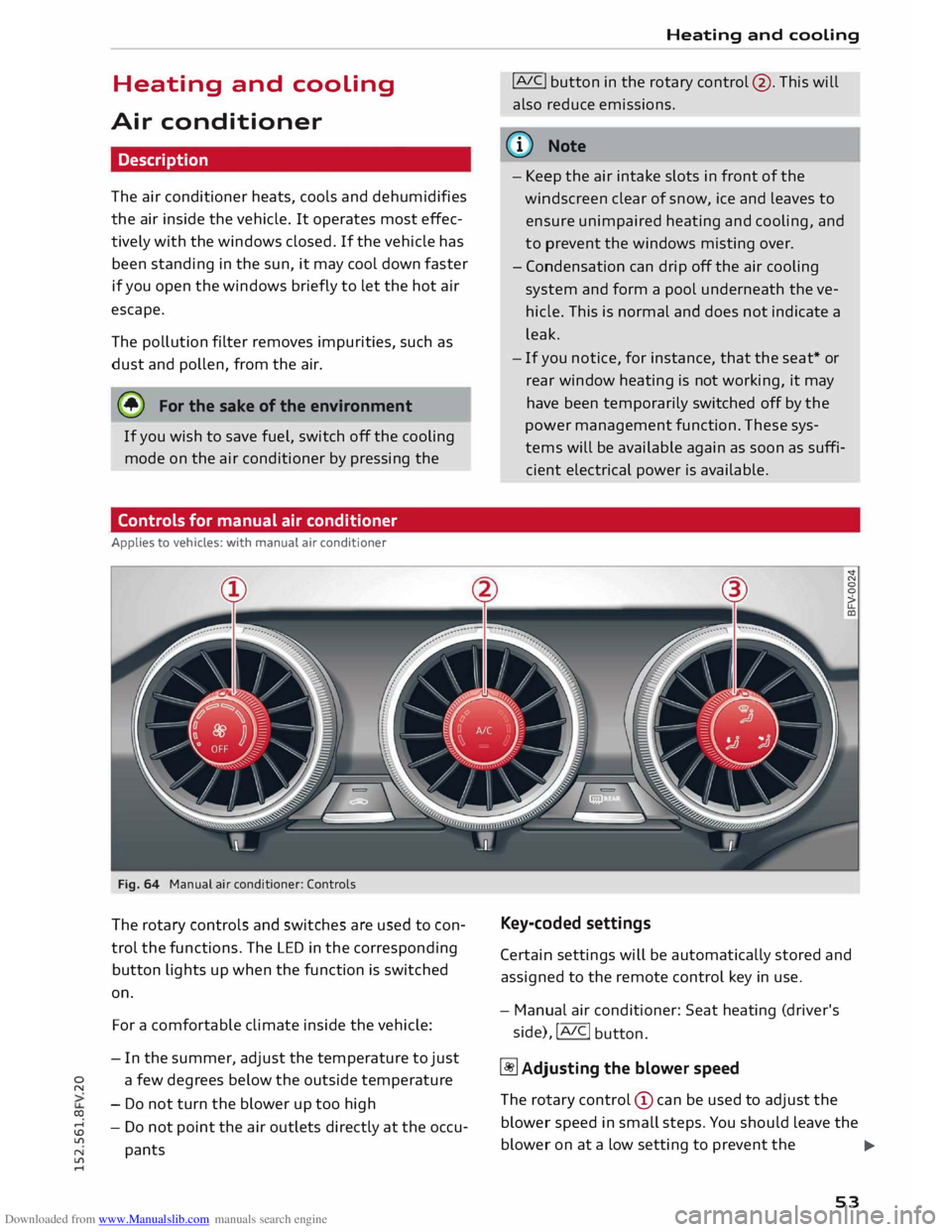
Downloaded from www.Manualslib.com manuals search engine 0
N
co
....
\D Lfl
N
Lfl
.... Heating
and cooling
Air conditioner
Description
The air conditioner heats, cools and dehumidifies
the air inside the vehicle. It operates most effec
tively with the windows closed. If the vehicle has
been standing in the sun, it may cool down faster
if you open the windows briefly to let the hot air
escape.
The pollution filter removes impurities, such as
dust and pollen, from the air.
@ For the sake of the environment
If you wish to save fuel, switch off the cooling
mode on the air conditioner by pressing the
Controls for manual air conditioner
Applies to vehicles: with manual air conditioner
Fig. 64 Manual air conditioner: Controls
The rotary controls and switches are used to con
trol the functions. The LED in the corresponding
button lights up when the function is switched
on.
For a comfortable climate inside the vehicle:
- In the summer, adjust the temperature to just
a few degrees below the outside temperature
- Do not turn the blower up too high
- Do not point the air outlets directly at the occu-
pants Heating
and cooling
!AJC! button in the rotary control @. This will
also reduce emissions.
ijJ} Note
- Keep the air intake slots in front of the
windscreen clear of snow, ice and leaves to
ensure unimpaired heating and cooling, and
to prevent the windows misting over.
- Condensation can drip off the air cooling
system and form a pool underneath the ve
hicle. This is normal and does not indicate a
leak.
- If you notice, for instance, that the seat* or
rear window heating is not working, it may
have been temporarily switched off by the
power management function. These sys
tems will be available again as soon as suffi
cient electrical power is available.
Key-coded settings
Certain settings will be automatically stored and
assigned to the remote control key in use.
- Manual air conditioner: Seat heating (driver's
side), !AIC!
button.
� Adjusting the blower speed
The rotary control (!) can be used to adjust the
blower speed in small steps. You should Leave the
blower on at a Low setting to prevent the
...,
53
Page 56 of 284
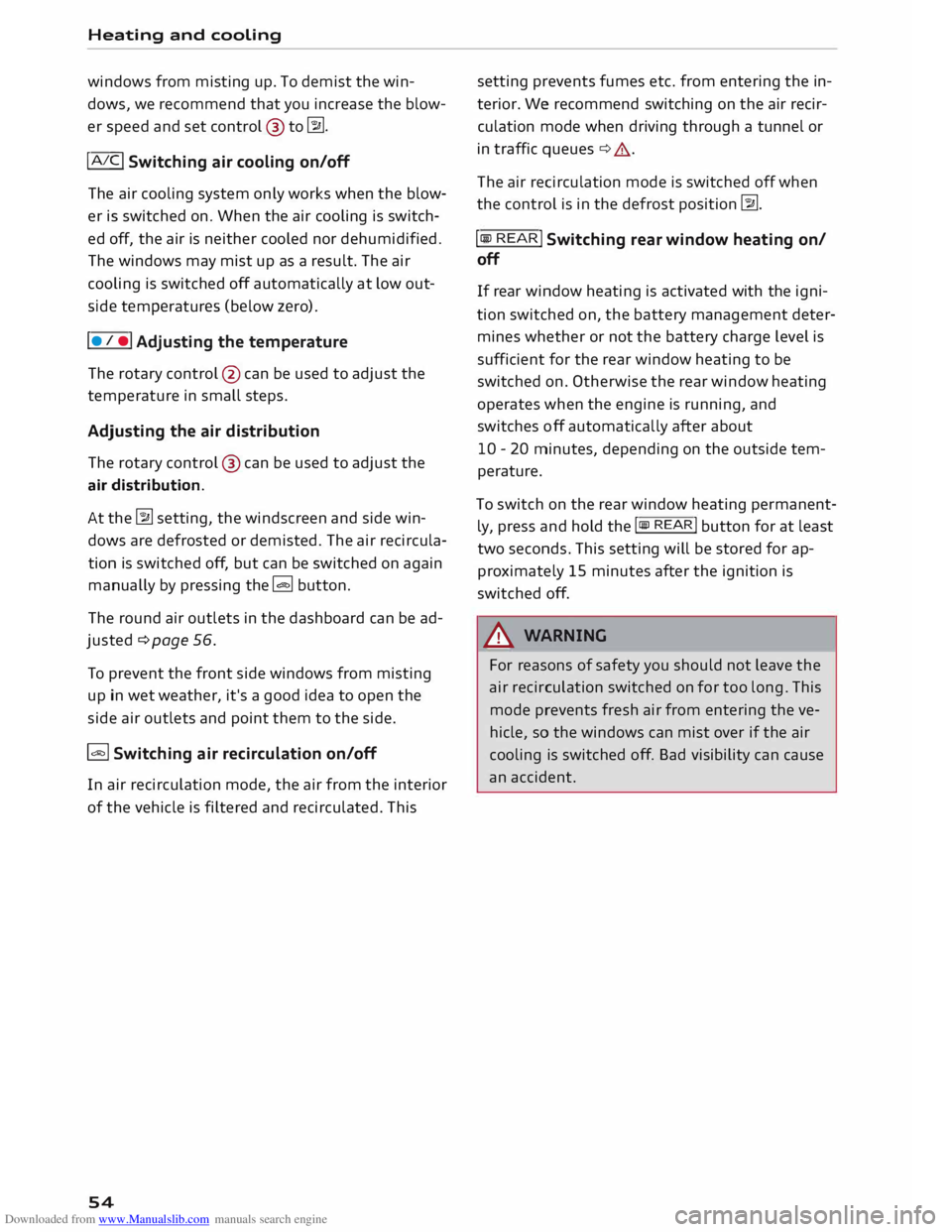
Downloaded from www.Manualslib.com manuals search engine Heating
and cooling
windows from misting up. To demist the win
dows, we recommend that you increase the blow
er speed and set control @ to�-
IAJC! Switching
air cooling on/off
The air cooling system only works when the blow
er is switched on. When the air cooling is switch
ed off, the air is neither cooled nor dehumidified.
The windows may mist up as a result. The air
cooling is switched off automatically at low out
side temperatures (below zero).
I• I •I
Adjusting the temperature
The rotary control @ can be used to adjust the
temperature in small steps.
Adjusting the air distribution
The rotary control @ can be used to adjust the
air distribution.
At the� setting, the windscreen and side win
dows are defrosted or demisted. The air recircula
tion is switched off, but can be switched on again
manually by pressing the� button.
The round air outlets in the dashboard can be ad
justed ¢ page 56.
To prevent the front side windows from misting
up in wet weather, it's a good idea to open the
side air outlets and point them to the side.
G;l Switching air recirculation on/off
In air recirculation mode, the air from the interior
of the vehicle is filtered and recirculated. This
54 setting
prevents fumes etc. from entering the in
terior. We recommend switching on the air recir
culation mode when driving through a tunnel or
in traffic queues ¢,&..
The air recirculation mode is switched off when
the control is in the defrost position�-
I@ REAR!
Switching rear window heating on/
off
If rear window heating is activated with the igni
tion switched on, the battery management deter
mines whether or not the battery charge level is
sufficient for the rear window heating to be
switched on. Otherwise the rear window heating
operates when the engine is running, and
switches off automatically after about
10 -20 minutes, depending on the outside tem
perature.
To switch on the rear window heating permanent
ly, press and hold the llllil REAR! button for at least
two seconds. This setting will be stored for ap
proximately 15 minutes after the ignition is
switched off.
_&. WARNING
For reasons of safety you should not leave the
air recirculation switched on for too long. This
mode prevents fresh air from entering the ve
hicle, so the windows can mist over if the air
cooling is switched off. Bad visibility can cause
an accident.
Page 57 of 284
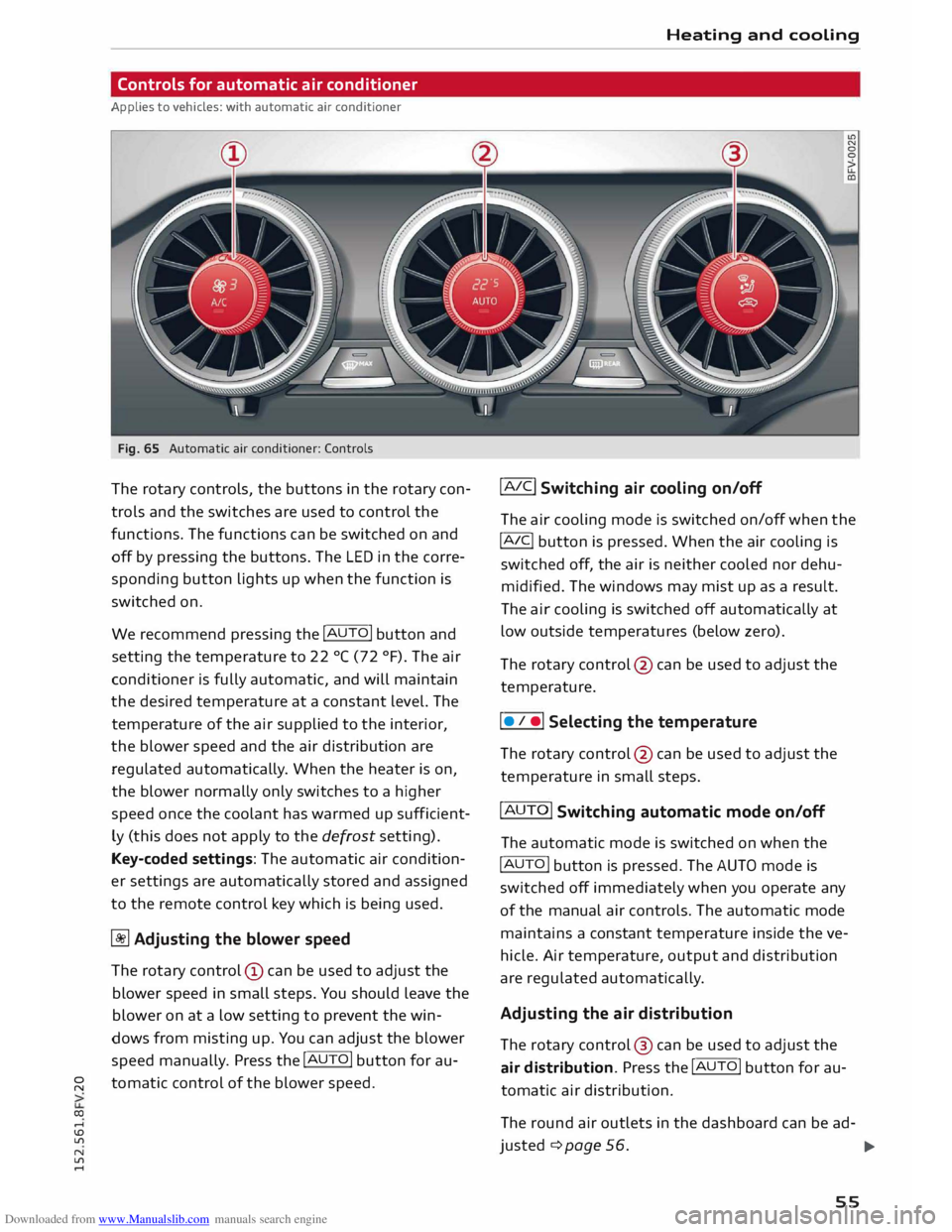
Downloaded from www.Manualslib.com manuals search engine Controls
for automatic air conditioner
Applies to vehicles: with automatic air conditioner
Fig. 65 Automatic air conditioner: Controls
The rotary controls, the buttons in the rotary con
trols and the switches are used to control the
functions. The functions can be switched on and
off by pressing the buttons. The LED in the corre
sponding button lights up when the function is
switched on.
We recommend pressing the !AUTO! button and
setting the temperature to 22 °C (72 °F). The air
conditioner is fully automatic, and will maintain
the desired temperature at a constant level. The
temperature of the air supplied to the interior,
the blower speed and the air distribution are
regulated automatically. When the heater is on,
the blower normally only switches to a higher
speed once the coolant has warmed up suff icient
ly (this does not apply to the defrost setting).
Key-coded settings: The automatic air condition
er settings are automatically stored and assigned
to the remote control key which is being used.
� Adjusting the blower speed
The rotary control (D can be used to adjust the
blower speed in small steps. You should leave the
blower on at a low setting to prevent the win
dows from misting up. You can adjust the blower
speed manually. Press the !AUTO! button for au-
� tomatic
control of the blower speed.
co ....
\D L/'l
N
L/'l
.... Heating
and cooling
IAIC! Switching air cooling on/off
The air cooling mode is switched on/off when the
!A IC
! button
is pressed. When the air cooling is
switched off, the air is neither cooled nor dehu
midified. The windows may mist up as a result.
The air cooling is switched off automatically at
low outside temperatures (below zero).
The rotary control @ can be used to adjust the
temperature.
I • I •I Selecting
the temperature
The rotary control @ can be used to adjust the
temperature in small steps.
IAUTO! Switching automatic mode on/off
The automatic mode is switched on when the
!AUTO I
button is pressed. The AUTO mode is
switched off immediately when you operate any
of the manual air controls. The automatic mode
maintains a constant temperature inside the ve
hicle. Air temperature, output and distribution
are regulated automatically.
Adjusting the air distribution
The rotary control @ can be used to adjust the
air distribution. Press the !AUTO! button for au
tomatic air distribution.
The round air outlets in the dashboard can be ad-
justed ¢ page 56.
..,.
55
Page 58 of 284
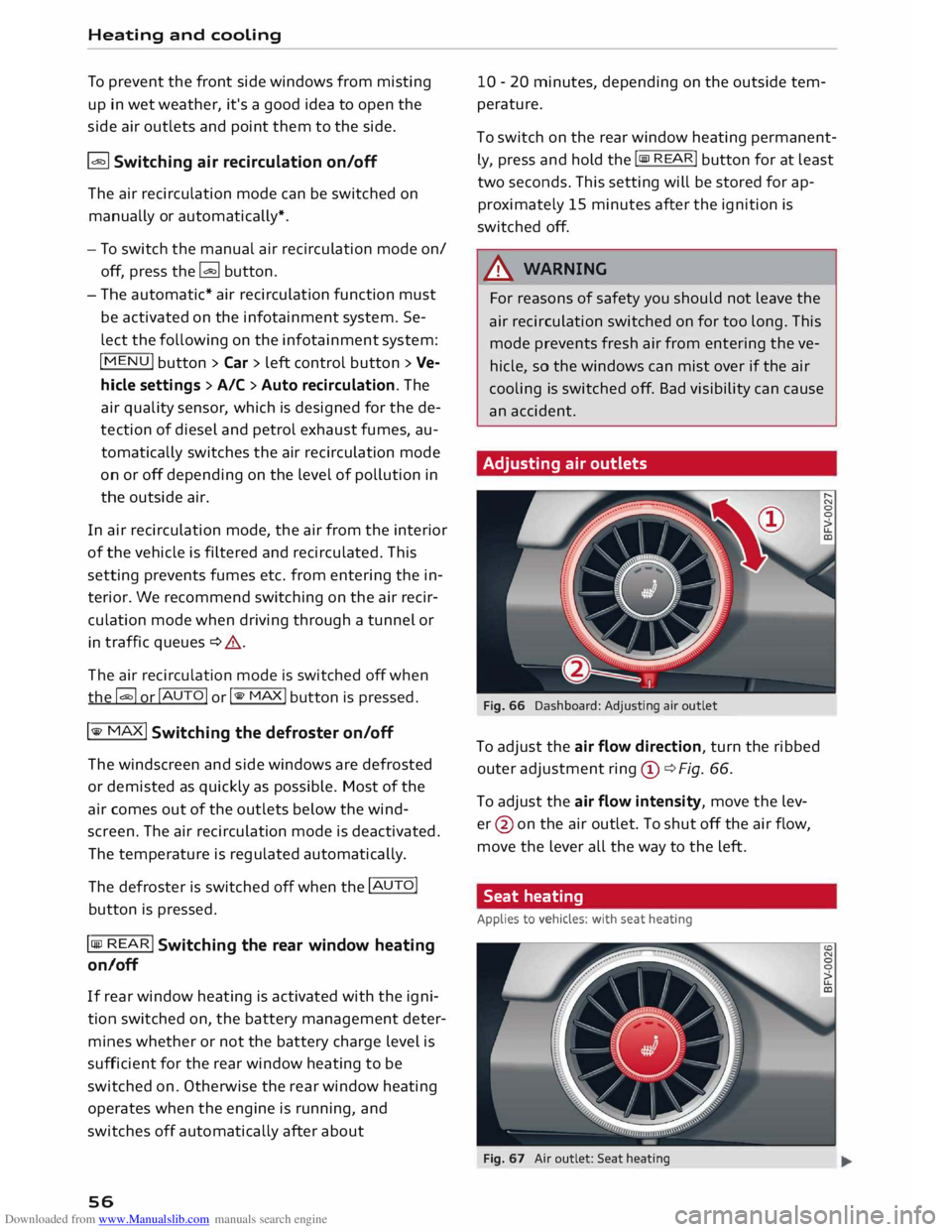
Downloaded from www.Manualslib.com manuals search engine Heating
and cooling
To prevent the front side windows from misting
up in wet weather, it's a good idea to open the
side air outlets and point them to the side.
� Switching air recirculation on/off
The air recirculation mode can be switched on
manually or automatically*.
- To switch the manual air recirculation mode on/
off, press the G;J button.
- The automatic* air recirculation function must
be activated on the infotainment system. Se
lect the following on the infotainment system:
I MENU I
button > Car > Left control button > Ve
hicle settings > A/C > Auto recirculation. The
air quality sensor, which is designed for the de
tec tion of diesel and petrol exhaust fumes, au
tomatically switches the air recirculation mode
on or off depending on the Level of pollution in
the outside air.
In air recirculation mode, the air from the interior
of the vehicle is filtered and recirculated. This
setting prevents fumes etc. from entering the in
terior. We recommend switching on the air recir
culation mode when driving through a tunnel or
in traffic
queues ¢ A.
The air recirculation mode is switched off when
the G;J or I AUTO
I or I
� M
AX
I button is pressed.
Iii) MAXI Switching
the defroster on/off
The windscreen and side windows are defrosted
or demisted as quickly as possible. Most of the
air comes out of the outlets below the wind
screen. The air recirculation mode is deactivated.
The temperature is regulated automatically.
The defroster is switched off when the !AUTO!
button is pressed.
!Clill RE
AR!
Switching the rear window heating
on/off
If rear window heating is activated with the igni
tion switched on, the battery management deter
mines whether or not the battery charge Level is
sufficient for the rear window heating to be
switched on. Otherwise the rear window heating
operates when the engine is running, and
switches off automatically after about
56 10
-20 minutes, depending on the outside tem
perature.
To switch on the rear window heating permanent
ly, press and hold the Imo RE A
R! button for at Least
two seconds. This setting will be stored for ap
proximately 15 minutes after the ignition is
switched off.
A WARNING
For reasons of safety you should not Leave the
air recirculation switched on for too Long. This
mode prevents fresh air from entering the ve
hicle, so the windows can mist over if the air
cooling is switched off. Bad visibility can cause
an accident.
Adjusting air outlets
Fig. 66 Dashboard: Adjusting air outlet
To adjust the air flow direction, turn the ribbed
outer adjustment ring©¢ Fig. 66.
To adjust the air flow intensity, move the Lev
er @ on the air outlet. To shut off the air flow,
move the Lever all the way to the Left.
Seat heating
Applies to vehicles: with seat heating
Fig. 67 Air outlet: Seat heating
Page 59 of 284
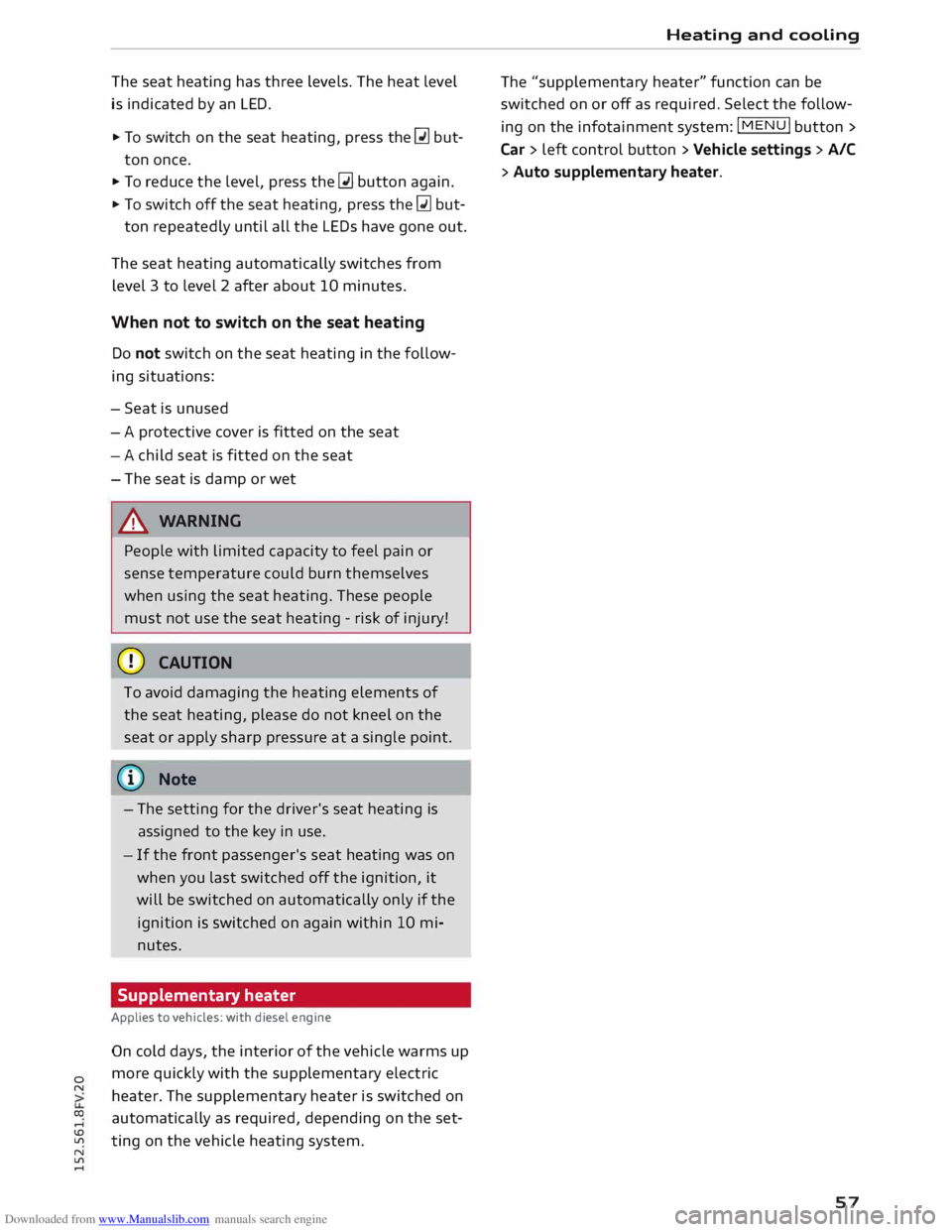
Downloaded from www.Manualslib.com manuals search engine 0
N
co
.-I
\D U'l
N
U'l
.-I The
seat heating has three levels. The heat level
is indicated by an LED.
,. To switch on the seat heating, press the� but
ton once.
,. To reduce the level, press the� button again.
,. To switch off the seat heating, press the [tJ but-
ton repeatedly until all the LEDs have gone out.
The seat heating automatically switches from
level 3 to level 2 after about 10 minutes.
When not to switch on the seat heating
Do not switch on the seat heating in the follow
ing situations:
- Seat is unused
- A protective cover is fitted on the seat
- A child seat is fitted on the seat
- The seat is damp or wet
_&. WARNING
People with limited capacity to feel pain or
sense temperature could burn themselves
when using the seat heating. These people
must not use the seat heating -risk of injury!
CD CAUTION
To avoid damaging the heating elements of
the seat heating, please do not kneel on the
seat or apply sharp pressure at a single point.
(I)) Note
- The setting for the driver's seat heating is
assigned to the key in use.
- If the front passenger's seat heating was on
when you last switched off the ignition, it
will be switched on automatically only if the
ignition is switched on again within 10 mi
nutes.
Supplementary heater
Applies to vehicles: with diesel engine
On cold days, the interior of the vehicle warms up
more quickly with the supplementary electric
heater. The supplementary heater is switched on
automatically as required, depending on the set
ting on the vehicle heating system. Heating
and cooling
The "supplementary heater" function can be
switched on or off as required. Select the follow
ing on the infotainment system: I MENU
I button >
Car > left control button > Vehicle settings > A/C
> Auto supplementary heater.
57
Page 60 of 284
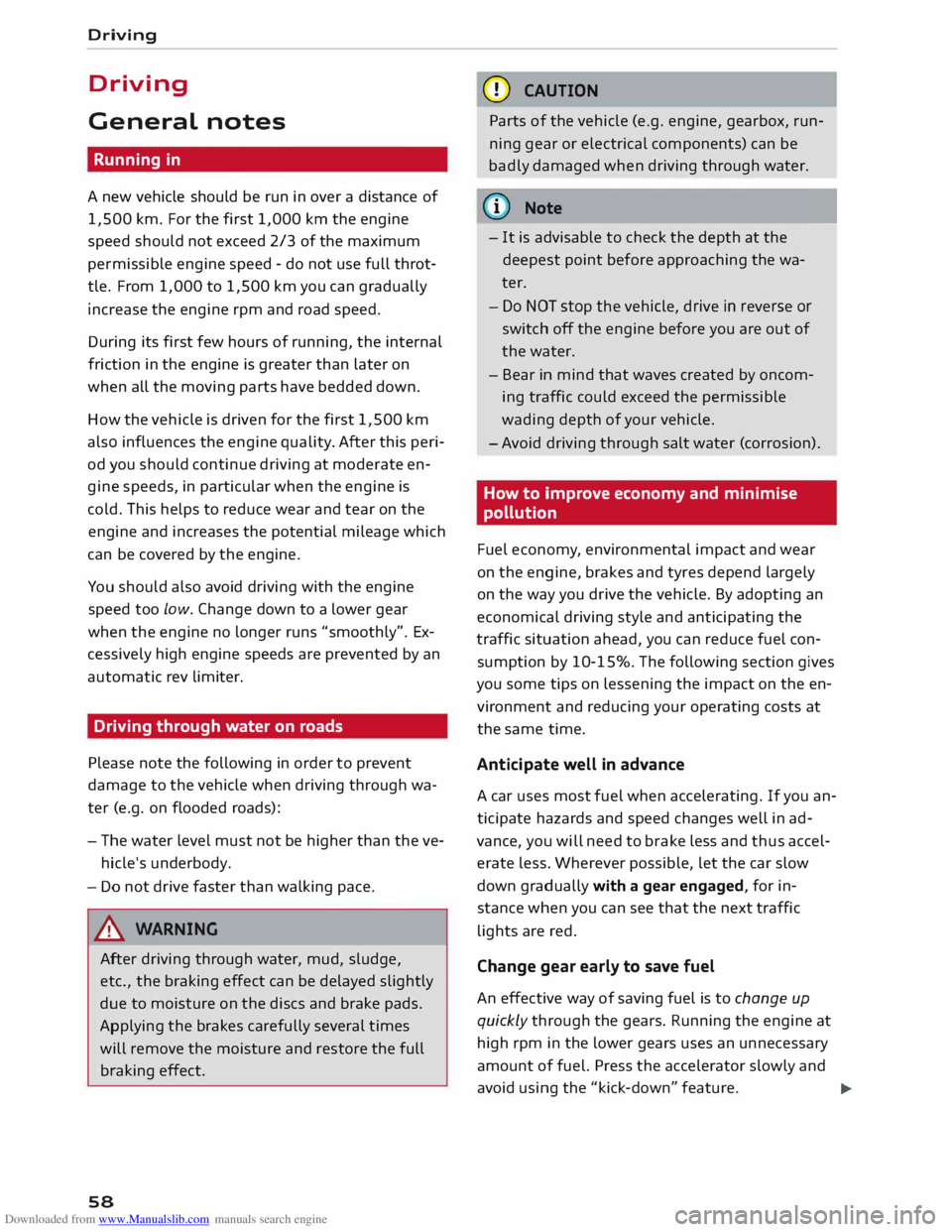
Downloaded from www.Manualslib.com manuals search engine Driving
Driving
General notes
Running in
A new vehicle should be run in over a distance of
1,500 km. For the first 1,000 km the engine
speed should not exceed 2/3 of the maximum
per missible engine speed -do not use full throt
tle. From 1,000 to 1,500 km you can gradually
increase the engine rpm and road speed.
During its first few hours of running, the internal
friction in the engine is greater than later on
when all the moving parts have bedded down.
How the vehicle is driven for the first 1,500 km
also influences the engine quality. After this peri
od you should continue driving at moderate en
gine speeds, in particular when the engine is
cold. This helps to reduce wear and tear on the
engine and increases the potential mileage which
can be covered by the engine.
You should also avoid driving with the engine
speed too Low. Change down to a lower gear
when the engine no longer runs "smoothly". Ex
cessively high engine speeds are prevented by an
automatic rev limiter.
Driving through water on roads
Please note the following in order to prevent
damage to the vehicle when driving through wa
ter (e.g. on flooded roads):
- The water level must not be higher than the ve
hicle's underbody.
- Do not drive faster than walking pace.
A WARNING
After driving through water, mud, sludge,
etc., the braking effect can be delayed slightly
due to moisture on the discs and brake pads.
Applying the brakes carefully several times
will remove the moisture and restore the full
braking effect.
58 CD
CAUTION
Parts of the vehicle (e.g. engine, gearbox, run
ning gear or electrical components) can be
badly damaged when driving through water.
ij} Note
- It is advisable to check the depth at the
deepest point before approaching the wa-
ter.
- Do NOT stop the vehicle, drive in reverse or
switch off the engine before you are out of
the water.
- Bear in mind that waves created by oncom
ing traffic could exceed the permissible
wading depth of your vehicle.
- Avoid driving through salt water (corrosion).
How to improve economy and minimise
pollution
Fuel econom y, environmental impact and wear
on the engine, brakes and tyres depend largely
on the way you drive the vehicle. By adopting an
economical driving style and anticipating the
traffic situation ahead, you can reduce fuel con
sumption by 10-15%. The following section gives
you some tips on lessening the impact on the en
vironment and reducing your operating costs at
the same time.
Anticipate well in advance
A car uses most fuel when accelerating. If you an
ticipate hazards and speed changes well in ad
vance, you will need to brake less and thus accel
erate less. Wherever possible, let the car slow
down gradually with a gear engaged, for in
stance when you can see that the next traffic
lights are red.
Change gear early to save fuel
An effective way of saving fuel is to change up
quickly through the gears. Running the engine at
high rpm in the lower gears uses an unnecessary
amount offuel. Press the accelerator slowly and
avoid using the "kick-down" feature.
...,